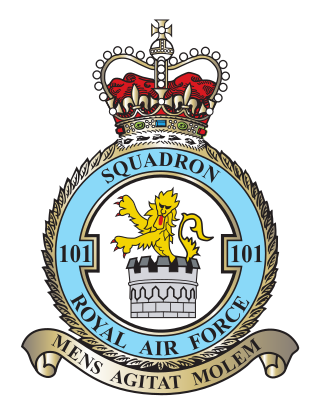
Royal Air Force Waddington otherwise known as RAF Waddington is a Royal Air Force station located beside the village of Waddington, 4.2 miles (6.8 km) south of Lincoln, Lincolnshire, in England.

No. 101 Squadron of the Royal Air Force operates the Airbus Voyager in the air-to-air refuelling and transport roles from RAF Brize Norton, Oxfordshire.

Royal Air Force Wyton or more simply RAF Wyton is a Royal Air Force station near St Ives, Cambridgeshire, England. The airfield is decommissioned and is now used by the UK Strategic Command.

Number 230 Squadron is an RAF squadron, currently based at Medicina Lines, Brunei, operating the Westland Puma HC2. The squadron was part of Royal Air Force Germany, operating the Puma HC.1 there from 1980. Following the drawdown at the end of the Cold War, the squadron disbanded on 30 April 1992. This was short-lived however and the squadron reformed at RAF Aldergrove on 4 May 1992, again with the Puma HC.1.
No. 213 Squadron was a squadron of the Royal Air Force. The squadron was formed on 1 April 1918 from No. 13 (Naval) Squadron of the Royal Naval Air Service. This RNAS squadron was itself formed on 15 January 1918 from the Seaplane Defence Flight which, since its creation in June 1917, had had the task of defending the seaplanes which flew out of Dunkirk.
No. 628 Squadron RAF was a meteorological and air-sea rescue squadron of the Royal Air Force during the Second World War.
No. 515 Squadron RAF was a squadron of the Royal Air Force formed during the Second World War. It ushered in Electronic countermeasures (ECM) warfare, jamming enemy radar installations from October 1942 as the only such squadron in the RAF initially. Later in the war 515 Sqn was joined by other squadrons as part of No. 100 Group RAF. The squadron disbanded after VE day, when the need for such a specialised squadron had reduced.

No. 543 Squadron RAF was a photographic reconnaissance squadron of the Royal Air Force, active in two periods between 1942 and 1974.
No. 666 Squadron was a Royal Air Force air observation post (AOP) squadron associated with the Canadian 1st Army and later part of the Royal Auxiliary Air Force. Numbers 651 to 663 Squadron of the RAF were air observation post units working closely with British Army units in artillery spotting and liaison. A further three of these squadrons, 664–666, were manned with Canadian personnel. Their duties and squadron numbers were transferred to the Army with the formation of the Army Air Corps on 1 September 1957
No. 191 Squadron was a Royal Air Force squadron. During World War I it was a non-operational night training unit, while during World War II it was engaged in maritime reconnaissance.

No. 192 Squadron was a Royal Air Force squadron operational during the First World War as a night training squadron and during the Second World War as a radar countermeasure unit. After the war the squadron served again in the Electronic Intelligence role, until disbanded in 1958.
No. 356 Squadron RAF was a short-lived long-range bomber squadron of the Royal Air Force between 1944 and 1945.

No. 355 Squadron RAF was a long-range bomber squadron based in British India from August 1943 until it disbanded in May 1946. Raised for service during the Second World War, the squadron was equipped with Consolidated Liberator aircraft and carried out operations against the Japanese during the Burma campaign.
No. 353 Squadron RAF was a Royal Air Force squadron, active during World War II carrying out maritime patrol and transport tasks.
No. 158 Squadron RAF was a World War I proposed ground attack squadron that did not become operational in time to see action, and a World War II bomber squadron. After World War II had ended in Europe the squadron operated in the transport role until disbandment in December 1945.
No. 540 Squadron RAF was a photoreconnaissance squadron of the Royal Air Force from 1942 to 1956.
No. 654 Squadron RAF was a unit of the Royal Air Force during the Second World War. Numbers 651 to 663 Squadrons of the RAF were air observation post units working closely with Army units in artillery spotting and liaison. Their duties and squadron numbers were transferred to the Army with the formation of the Army Air Corps on 1 September 1957.

No. 657 Squadron RAF was a unit of the Royal Air Force in North Africa, Italy and the Netherlands during the Second World War and afterwards in Germany. Numbers 651 to 663 Squadrons of the RAF were air observation post units working closely with British Army units in artillery spotting and liaison. Their duties and squadron numbers were transferred to the Army with the formation of the Army Air Corps on 1 September 1957.
No. 527 Squadron RAF was a radar calibration unit of the Royal Air Force between 1943 and 1958.
No. 542 Squadron RAF was a Royal Air Force Squadron formed as a photographic reconnaissance squadron in World War II that reformed in the post war period.









